-
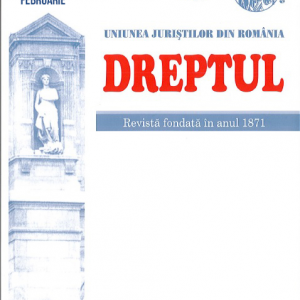 This second part of the study addressing the legal regime of the exception of unconstitutionality and the impact of such legal instrument on ensuring the constitutional order focuses on the admissibility conditions of requests to refer an exception of unconstitutionality to the Constitutional Court of Romania as well as the grounds for finding an exception of unconstitutionality inadmissible. In this context, there is strong emphasis placed on divergent case law approaches, which seems symptomatic for a certain „eccentric” tendency of construing the long-standing type of constitutional review enshrined in the Romanian Constitution. The conclusions of the study suggest the need for giving careful consideration to the manner of tackling such referrals to the Constitutional Court so as to remain in line with the structural requirements relating to the constitutional review as enshrined in our fundamental law.
This second part of the study addressing the legal regime of the exception of unconstitutionality and the impact of such legal instrument on ensuring the constitutional order focuses on the admissibility conditions of requests to refer an exception of unconstitutionality to the Constitutional Court of Romania as well as the grounds for finding an exception of unconstitutionality inadmissible. In this context, there is strong emphasis placed on divergent case law approaches, which seems symptomatic for a certain „eccentric” tendency of construing the long-standing type of constitutional review enshrined in the Romanian Constitution. The conclusions of the study suggest the need for giving careful consideration to the manner of tackling such referrals to the Constitutional Court so as to remain in line with the structural requirements relating to the constitutional review as enshrined in our fundamental law. -
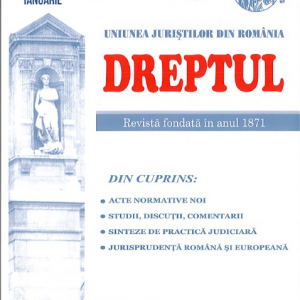 The present study addresses a topic surrounded by increasing heated debate in the Romanian legal jurisprudence, namely the legal regime of the exception of unconstitutionality and the impact of such legal instrument on ensuring the constitutional order. The first part of the study explores the citizens’ access to constitutional justice, as designed both in the American model and in the European model. Further, the solution adopted in the Romanian constitutional system, as part of the European model of constitutional justice, is outlined. The analysis subsequently deepens the configuration of the a posteriori constitutional review in terms of setting forth the distribution of attributions with respect to this type of review as well as the nature, content, effects, and legal regime of referrals to the Constitutional Court of Romania dealing with exceptions of unconstitutionality.
The present study addresses a topic surrounded by increasing heated debate in the Romanian legal jurisprudence, namely the legal regime of the exception of unconstitutionality and the impact of such legal instrument on ensuring the constitutional order. The first part of the study explores the citizens’ access to constitutional justice, as designed both in the American model and in the European model. Further, the solution adopted in the Romanian constitutional system, as part of the European model of constitutional justice, is outlined. The analysis subsequently deepens the configuration of the a posteriori constitutional review in terms of setting forth the distribution of attributions with respect to this type of review as well as the nature, content, effects, and legal regime of referrals to the Constitutional Court of Romania dealing with exceptions of unconstitutionality. -
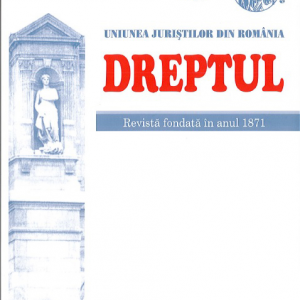 In the present article, the author analyzes twenty-four judgments of the European Court of Human Rights pronounced in the cases regarding the Revolution of 1989, by which it was established that Romania violated, mainly, the procedural side of Article 2 (right to life) of the (European) Convention for the Protection of Human Rights and Fundamental Freedoms. The author also identifies the advantages and disadvantages of the procedure by which the Committee of Ministers of the Council of Europe supervises the enforcement by Romania of those judgments. Finally, the article aims to assess the impact that the judgements of the European Court of Human Rights have had in recent years on the conduct of internal investigations, i.e. the so-called „File of the Revolution”.
In the present article, the author analyzes twenty-four judgments of the European Court of Human Rights pronounced in the cases regarding the Revolution of 1989, by which it was established that Romania violated, mainly, the procedural side of Article 2 (right to life) of the (European) Convention for the Protection of Human Rights and Fundamental Freedoms. The author also identifies the advantages and disadvantages of the procedure by which the Committee of Ministers of the Council of Europe supervises the enforcement by Romania of those judgments. Finally, the article aims to assess the impact that the judgements of the European Court of Human Rights have had in recent years on the conduct of internal investigations, i.e. the so-called „File of the Revolution”. -
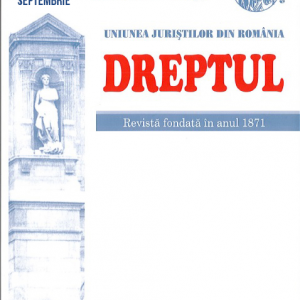 The law branches constitutionalization issues – therefore, also of civil law – came up acutely in Europe after the Second World War, initially in the Federal Republic of Germany and then shortly after, in France and after 1990 in Romania. This study examines the issues mentioned noting that the term of constitutionalization of the law branches is the fundamental human rights effect on the legal system of each State.
The law branches constitutionalization issues – therefore, also of civil law – came up acutely in Europe after the Second World War, initially in the Federal Republic of Germany and then shortly after, in France and after 1990 in Romania. This study examines the issues mentioned noting that the term of constitutionalization of the law branches is the fundamental human rights effect on the legal system of each State. -
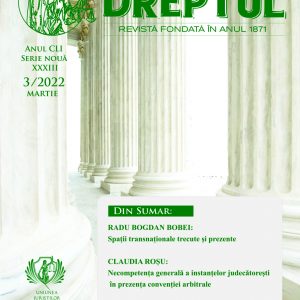 The construction of the Romano-Germanic family law system is an interesting phenomena build around Roman law, which became a principle or a norm of thought for the European juridical thinking, and also around the law of Germanic people who colored the juridical European life and determined the process of codification. Thus, the article addresses the interesting issue of the combination process between Roman law with the law of the Germanic people, indispensable for the understanding of the Romano- Germanic family law system and for underlying the differences between this system and the common-law system. This is an important process, considering that a considerable part of the juridical systems of the world are founded around the family law system.
The construction of the Romano-Germanic family law system is an interesting phenomena build around Roman law, which became a principle or a norm of thought for the European juridical thinking, and also around the law of Germanic people who colored the juridical European life and determined the process of codification. Thus, the article addresses the interesting issue of the combination process between Roman law with the law of the Germanic people, indispensable for the understanding of the Romano- Germanic family law system and for underlying the differences between this system and the common-law system. This is an important process, considering that a considerable part of the juridical systems of the world are founded around the family law system. -
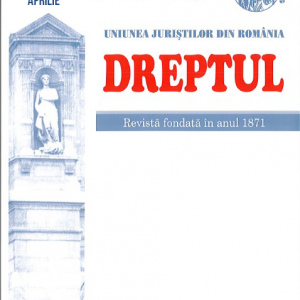 The professional civil liability insurance of physicians is perceived as an additional pecuniary charge of those who want to practice, however, given the increasing number of complaints against some acts of medical malpractice and the moral damages in high quantum granted by the courts to the injured parties, in reality it becomes a real means to protect the property of these professionals. The occurrence of an error in conducting the professional act is possible at any time, which is why a special emphasis is given to taking ex ante measures in order to manage the possible materialisation of an act of malpractice. Such a prophylaxis measure is the negotiation for concluding an insurance contract for professional civil liability, which provides protection for a wide range of risks, compensates several possible types of damage, establishes the limit of the insured amount as high as possible. The plurality of the professional civil liability insurances significantly increases the degree of patrimonial protection of the insured.
The professional civil liability insurance of physicians is perceived as an additional pecuniary charge of those who want to practice, however, given the increasing number of complaints against some acts of medical malpractice and the moral damages in high quantum granted by the courts to the injured parties, in reality it becomes a real means to protect the property of these professionals. The occurrence of an error in conducting the professional act is possible at any time, which is why a special emphasis is given to taking ex ante measures in order to manage the possible materialisation of an act of malpractice. Such a prophylaxis measure is the negotiation for concluding an insurance contract for professional civil liability, which provides protection for a wide range of risks, compensates several possible types of damage, establishes the limit of the insured amount as high as possible. The plurality of the professional civil liability insurances significantly increases the degree of patrimonial protection of the insured. -
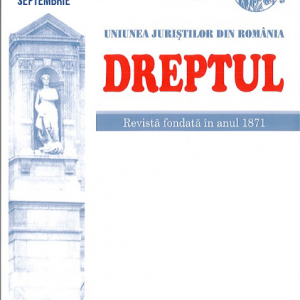 By means of this study, the author tends to point out that, despite the principle of „equality before the law of the children born out of wedlock to the children born in wedlock”, provided by Article 48 (3) of the Constitution and reaffirmed by Article 260 of the Romanian Civil Code, in the Romanian law, no less, there are situations of „different legal treatment” of the two categories of children. Specifically, it is raised for discussion the different legal regulation of some aspects, as in the cases relating to: „determination of the paternity”, „acquiring the name”, „confirmation of the filiation” and „prohibition of the adoption of children whose parents did not reach the age of 14”. Likewise, for the situations noted, the author substantiates de lege ferenda proposals meant to ensure respect for the principle of equality before the law of children born out of wedlock to those born in wedlock.
By means of this study, the author tends to point out that, despite the principle of „equality before the law of the children born out of wedlock to the children born in wedlock”, provided by Article 48 (3) of the Constitution and reaffirmed by Article 260 of the Romanian Civil Code, in the Romanian law, no less, there are situations of „different legal treatment” of the two categories of children. Specifically, it is raised for discussion the different legal regulation of some aspects, as in the cases relating to: „determination of the paternity”, „acquiring the name”, „confirmation of the filiation” and „prohibition of the adoption of children whose parents did not reach the age of 14”. Likewise, for the situations noted, the author substantiates de lege ferenda proposals meant to ensure respect for the principle of equality before the law of children born out of wedlock to those born in wedlock. -
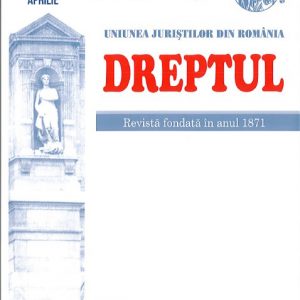 This study is devoted to a very present topic, namely that of the liability of the State and of the magistrates for the judicial errors produced in the criminal cases or other type of cases. After a brief introduction to the subject, the author makes an analysis of comparative law in the matter subject to examination, pointing out that, in most European countries, the dominant system is that of establishing the liability of the State and of the magistrates for the judicial errors. The author also presents us some of the solutions of the common law system, where the principle is that of impunity of the magistrates for the judicial errors. The author emphasizes that, in our law, the liability of the State is the dominant one and it has the character of an objective liability, founded on the provisions of Article 52 (3) of the Romanian Constitution. There are also analyzed in this article the procedural conditions of the liability of the State for the judicial errors. A special place in this study is devoted to the liability of the magistrates, particularly of the judges, for the judicial errors. It is emphasized, in particular, the subsidiary nature of the liability of the magistrates, as well as the fact that their liability may be engaged only under the subjective conditions specifically determined by the law, respectively in the situations where they have acted in their judicial function in „bad faith” or with „obvious negligence”. The author pleads for maintaining this solution in the future as well, the only one that, in his opinion, is meant to achieve the necessary balance between the independence of the judge and the necessary social and legal responsibility. At the end of the study there are also formulated some legislative proposals, such as those relating to setting some common time limits in civil and criminal matters, to establishing the obligation of the State to exercise the action for regress, to the professional liability insurance of magistrates etc.
This study is devoted to a very present topic, namely that of the liability of the State and of the magistrates for the judicial errors produced in the criminal cases or other type of cases. After a brief introduction to the subject, the author makes an analysis of comparative law in the matter subject to examination, pointing out that, in most European countries, the dominant system is that of establishing the liability of the State and of the magistrates for the judicial errors. The author also presents us some of the solutions of the common law system, where the principle is that of impunity of the magistrates for the judicial errors. The author emphasizes that, in our law, the liability of the State is the dominant one and it has the character of an objective liability, founded on the provisions of Article 52 (3) of the Romanian Constitution. There are also analyzed in this article the procedural conditions of the liability of the State for the judicial errors. A special place in this study is devoted to the liability of the magistrates, particularly of the judges, for the judicial errors. It is emphasized, in particular, the subsidiary nature of the liability of the magistrates, as well as the fact that their liability may be engaged only under the subjective conditions specifically determined by the law, respectively in the situations where they have acted in their judicial function in „bad faith” or with „obvious negligence”. The author pleads for maintaining this solution in the future as well, the only one that, in his opinion, is meant to achieve the necessary balance between the independence of the judge and the necessary social and legal responsibility. At the end of the study there are also formulated some legislative proposals, such as those relating to setting some common time limits in civil and criminal matters, to establishing the obligation of the State to exercise the action for regress, to the professional liability insurance of magistrates etc. -
 The way of exercising the parental rights and duties suffered after the adoption in 2009 of the Civil Code significant amendments as compared to the previous regulation. At the time of elaboration of the current Criminal Code, especially of the Chapter reserved to the family offences, this aspect has not been taken into account, so currently it is established the lack of synchronicity between the two regulations. The current regulation of the offence of non-compliance with the measures regarding minors, provided by Article 379 of the Criminal Code, refers to family relations that do not cover the new socio-economic realities, in which it is witnessed the labour migration from Romania to other states, in many cases doubled by the dissolution of some families. Similarly, the situations in which the children are left in the care of other persons or where the distance between the child and one or both parents is beyond the borders of a state become increasingly frequent.
The way of exercising the parental rights and duties suffered after the adoption in 2009 of the Civil Code significant amendments as compared to the previous regulation. At the time of elaboration of the current Criminal Code, especially of the Chapter reserved to the family offences, this aspect has not been taken into account, so currently it is established the lack of synchronicity between the two regulations. The current regulation of the offence of non-compliance with the measures regarding minors, provided by Article 379 of the Criminal Code, refers to family relations that do not cover the new socio-economic realities, in which it is witnessed the labour migration from Romania to other states, in many cases doubled by the dissolution of some families. Similarly, the situations in which the children are left in the care of other persons or where the distance between the child and one or both parents is beyond the borders of a state become increasingly frequent. -
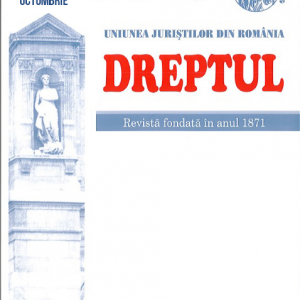 Prin Constituția din 1991 s-a înființat în România, pentru prima dată în istoria sa, Curtea Constituțională, rolul său fiind de garant al supremației Constituției. Ulterior, a fost adoptată Legea nr. 47/1992 privind organizarea și funcționarea Curții Constituționale1. Constituția revizuită în 2003 (titlul V intitulat „Curtea Constituțională”), Legea nr. 47/1992 privind organizarea și funcționarea Curții Constituționale și Regulamentul de organizare și funcționare a Curții Constituționale, aprobat prin Hotărârea nr. 6/2012 a Plenului Curții Constituționale2, alcătuiesc cadrul legal de manifestare a competenței Curții Constituționale.
Prin Constituția din 1991 s-a înființat în România, pentru prima dată în istoria sa, Curtea Constituțională, rolul său fiind de garant al supremației Constituției. Ulterior, a fost adoptată Legea nr. 47/1992 privind organizarea și funcționarea Curții Constituționale1. Constituția revizuită în 2003 (titlul V intitulat „Curtea Constituțională”), Legea nr. 47/1992 privind organizarea și funcționarea Curții Constituționale și Regulamentul de organizare și funcționare a Curții Constituționale, aprobat prin Hotărârea nr. 6/2012 a Plenului Curții Constituționale2, alcătuiesc cadrul legal de manifestare a competenței Curții Constituționale. -
 The study is dedicated to celebrating the centenary of the achievement of the national unity of the Romanian people and it is devoted to some of the legislative, doctrinal and jurisprudential evolutions and mutations occurred, during this period, within the institution of civil obligations. The author shows that the evolutions in question have their etiology and explanation in the social needs, determined by the specificity of the historical stages and of the political regimes which the Romanian society has gone through. His approach is placed in the general context of the most relevant changes that have occurred, over the years, in the texts of the Civil Code and of the related legislation. This explains why the study starts with an introductory paragraph, in which it is presented the general state of the old Civil Code and there are set forth its main changes, occurred after 1918.
The study is dedicated to celebrating the centenary of the achievement of the national unity of the Romanian people and it is devoted to some of the legislative, doctrinal and jurisprudential evolutions and mutations occurred, during this period, within the institution of civil obligations. The author shows that the evolutions in question have their etiology and explanation in the social needs, determined by the specificity of the historical stages and of the political regimes which the Romanian society has gone through. His approach is placed in the general context of the most relevant changes that have occurred, over the years, in the texts of the Civil Code and of the related legislation. This explains why the study starts with an introductory paragraph, in which it is presented the general state of the old Civil Code and there are set forth its main changes, occurred after 1918. -
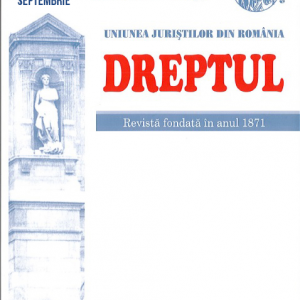 As a result of the measures taken at the level of the Member States in order to combat the COVID-19 pandemic, the statistics show that the number of teleworkers has increased and, at the same time, telework can become an „endless job” with negative effects on the mental and physical health condition of teleworkers. In this context, at the level of the European Union, it was appreciated that it is necessary to secure the labour relations of teleworkers by unification of the legislations of the Member States in terms of the right to disconnect. The implicit way of regulating this right, which also exists in Romania, does not create an adequate protection for teleworkers. Exercising the right to disconnect implies a clear delimitation of the working time and of the rest time and the obligation of employers to monitor and measure the daily working time provided by teleworkers, as it results from the case law of the Court of Justice of the European Union. The role of the social partners is essential for the implementation of the right to disconnect and appropriate individual information measures must be taken in order to ensure that the employee is sensitized and made aware of the risks associated with permanent availability. Artificial intelligence creates the premises for telework to evolve into smartworking, which gives the teleworker full autonomy in choosing the place where he performs work.
As a result of the measures taken at the level of the Member States in order to combat the COVID-19 pandemic, the statistics show that the number of teleworkers has increased and, at the same time, telework can become an „endless job” with negative effects on the mental and physical health condition of teleworkers. In this context, at the level of the European Union, it was appreciated that it is necessary to secure the labour relations of teleworkers by unification of the legislations of the Member States in terms of the right to disconnect. The implicit way of regulating this right, which also exists in Romania, does not create an adequate protection for teleworkers. Exercising the right to disconnect implies a clear delimitation of the working time and of the rest time and the obligation of employers to monitor and measure the daily working time provided by teleworkers, as it results from the case law of the Court of Justice of the European Union. The role of the social partners is essential for the implementation of the right to disconnect and appropriate individual information measures must be taken in order to ensure that the employee is sensitized and made aware of the risks associated with permanent availability. Artificial intelligence creates the premises for telework to evolve into smartworking, which gives the teleworker full autonomy in choosing the place where he performs work. -
 Procedura succesorală, procedură prin care se transpun în practică dispozițiile normative ce vizează succesiunile și transmisiunea acestora, poate fi după natura sa o procedură litigioasă sau una nelitigioasă, aceasta ținând strict de competența acordată instanțelor de judecată sau notarului public.
Procedura succesorală, procedură prin care se transpun în practică dispozițiile normative ce vizează succesiunile și transmisiunea acestora, poate fi după natura sa o procedură litigioasă sau una nelitigioasă, aceasta ținând strict de competența acordată instanțelor de judecată sau notarului public. -
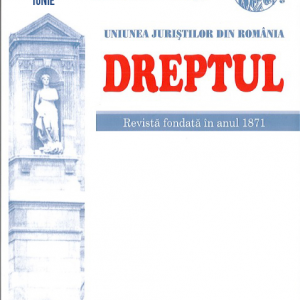 The article intends to assess the quite difficult but, especially, dramatic issue of the criminal liability of minors and of preventing and fighting juvenile delinquency, starting from the incontestable reality of the phenomenon of offences among young people. It examines the conditions for the criminal liability of minors by means of a comparative analysis of the current regulation and the regulation proposed by the new Criminal Code, emphasizing the evolution recorded in their punishment, from the perspective of the entirely special situation of minors, caused by their psycho-physical characteristics. In this study, a special emphasis is laid on the consequences of the lawmaker’s eliminating the enforcement of penalties to minors on their real reeducation and social reinsertion.
The article intends to assess the quite difficult but, especially, dramatic issue of the criminal liability of minors and of preventing and fighting juvenile delinquency, starting from the incontestable reality of the phenomenon of offences among young people. It examines the conditions for the criminal liability of minors by means of a comparative analysis of the current regulation and the regulation proposed by the new Criminal Code, emphasizing the evolution recorded in their punishment, from the perspective of the entirely special situation of minors, caused by their psycho-physical characteristics. In this study, a special emphasis is laid on the consequences of the lawmaker’s eliminating the enforcement of penalties to minors on their real reeducation and social reinsertion. -
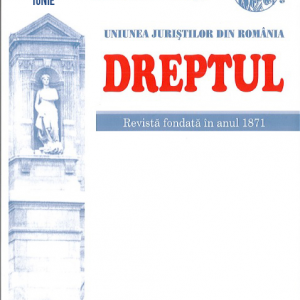 The article intends to assess the quite difficult but, especially, dramatic issue of the criminal liability of minors and of preventing and fighting juvenile delinquency, starting from the incontestable reality of the phenomenon of offences among young people. It examines the conditions for the criminal liability of minors by means of a comparative analysis of the current regulation and the regulation proposed by the new Criminal Code, emphasizing the evolution recorded in their punishment, from the perspective of the entirely special situation of minors, caused by their psycho-physical characteristics. In this study, a special emphasis is laid on the consequences of the lawmaker’s eliminating the enforcement of penalties to minors on their real reeducation and social reinsertion.
The article intends to assess the quite difficult but, especially, dramatic issue of the criminal liability of minors and of preventing and fighting juvenile delinquency, starting from the incontestable reality of the phenomenon of offences among young people. It examines the conditions for the criminal liability of minors by means of a comparative analysis of the current regulation and the regulation proposed by the new Criminal Code, emphasizing the evolution recorded in their punishment, from the perspective of the entirely special situation of minors, caused by their psycho-physical characteristics. In this study, a special emphasis is laid on the consequences of the lawmaker’s eliminating the enforcement of penalties to minors on their real reeducation and social reinsertion. -
 The study intends to make a comparative analysis of the legal provisions of the Romanian Civil Code from 1864, in relation to those of the current Civil Code, regarding the tort civil liability, highlighting similarities and differences between the two regulations, by presenting some novelty elements which the legislator brought to the current Civil Code. It was envisaged a historical presentation of the doctrinal conceptions regarding the civil liability, based initially on the subjective theory and the evolution towards the objective approach of liability, in the variants of profit risk, of the risk of authority and the risk of activity, by specifying the coexistence of the two foundations of liability, subjective and objective, and of the scope of each of them. Our attention is retained by the presentation of the foundation of civil liability in the system of national law, the elements of convergence and divergence between civil liability and contractual civil liability, the technical forms of tort liability, the liability for one’s own deed, the guilt and liability exonerating causes, the civil illicitness and the causes of removal of the illicit nature of the deed, the tort liability of the legal person, the novelties of the regulation of the liability for the deed of another (minors, persons under interdiction, the liability of the principals for the damage caused by minors) and the legal foundation of this liability, the liability for the damage caused by animals and the ruin of the edifice. It is also retained the new vision of the current Civil Code in the matter of liability for things, with special regard to the matter of collision of vehicles and the legal basis of this liability.
The study intends to make a comparative analysis of the legal provisions of the Romanian Civil Code from 1864, in relation to those of the current Civil Code, regarding the tort civil liability, highlighting similarities and differences between the two regulations, by presenting some novelty elements which the legislator brought to the current Civil Code. It was envisaged a historical presentation of the doctrinal conceptions regarding the civil liability, based initially on the subjective theory and the evolution towards the objective approach of liability, in the variants of profit risk, of the risk of authority and the risk of activity, by specifying the coexistence of the two foundations of liability, subjective and objective, and of the scope of each of them. Our attention is retained by the presentation of the foundation of civil liability in the system of national law, the elements of convergence and divergence between civil liability and contractual civil liability, the technical forms of tort liability, the liability for one’s own deed, the guilt and liability exonerating causes, the civil illicitness and the causes of removal of the illicit nature of the deed, the tort liability of the legal person, the novelties of the regulation of the liability for the deed of another (minors, persons under interdiction, the liability of the principals for the damage caused by minors) and the legal foundation of this liability, the liability for the damage caused by animals and the ruin of the edifice. It is also retained the new vision of the current Civil Code in the matter of liability for things, with special regard to the matter of collision of vehicles and the legal basis of this liability. -
 The present study analyzes how the trial procedure for the application for voluntary intervention was regulated by the Law No 134/2010 on the Civil Procedure Code and the arguments for which the author considers that it is not justified to change this procedure by the Law No 310/2018 for amending and supplementing the Law No 134/2010 on the Civil Procedure Code, as well as for amending and supplementing other normative acts. The result of the study is reflected in the opinion according to which the conclusion of rejection as inadmissible of the application for voluntary intervention had to be maintained in the form existing before the adoption of the Law No 310/2018, namely that it can be challenged separately. Thus, the conclusion of the admission in principle could only be challenged at the same time with the merits, whereas in the event that the application for intervention is rejected as inadmissible, the conclusion could be appealed within 5 days, which was running from ruling for the present part, respectively from the communication for the missing part. The legal remedy was only the appeal, if the conclusion was given at first instance, respectively only the review to the hierarchically superior court, if the conclusion was pronounced in appeal. The settlement of the legal remedy took place within a short time limit of no more than 10 days of registration, the file being submitted to the judicial control court in a certified copy for conformity with the original, within 24 hours of the expiration of the time limit. The legal remedy had suspensive effect, the examination of the main claim being suspended until the appeal is settled. By the Law No 310/2018 it was amended the court procedure, referring to the means of appeal that can be exercised against the conclusion through which the application for voluntary intervention was settled. In this regard, irrespective of the fact that the court admits or rejects the application, the conclusion can only be challenged at the same time with the merits. In this way, the potential intervener has to wait for the finalisation of the litigation to be settled before the first instance or before the court of appeal, in order to be able to benefit by his right. If the means of appeal exercised against the conclusion of rejection of the application for intervention as inadmissible, the judgment pronounced is cancelled by law, following that the case be re-judged by the court before which the application for intervention was formulated, which is usually the first instance, but, by exception, it may also be the instance of appeal. The resumption of the trial is made at the time when the admissibility in principle of the application for intervention is discussed. In the author’s opinion, by the re-examination at this point, the process is delayed, since all the procedural acts carried out must be resumed. Maintaining the possibility of separately challenging of the conclusion of rejection as inadmissible of the application for voluntary intervention, in the author’s opinion, was contributing to the unitary settlement of the litigation at the first instance, and by regulating some short time limits for the means of appeal, it was ensured the compliance with a reasonable time limit for the finalisation of the trial.
The present study analyzes how the trial procedure for the application for voluntary intervention was regulated by the Law No 134/2010 on the Civil Procedure Code and the arguments for which the author considers that it is not justified to change this procedure by the Law No 310/2018 for amending and supplementing the Law No 134/2010 on the Civil Procedure Code, as well as for amending and supplementing other normative acts. The result of the study is reflected in the opinion according to which the conclusion of rejection as inadmissible of the application for voluntary intervention had to be maintained in the form existing before the adoption of the Law No 310/2018, namely that it can be challenged separately. Thus, the conclusion of the admission in principle could only be challenged at the same time with the merits, whereas in the event that the application for intervention is rejected as inadmissible, the conclusion could be appealed within 5 days, which was running from ruling for the present part, respectively from the communication for the missing part. The legal remedy was only the appeal, if the conclusion was given at first instance, respectively only the review to the hierarchically superior court, if the conclusion was pronounced in appeal. The settlement of the legal remedy took place within a short time limit of no more than 10 days of registration, the file being submitted to the judicial control court in a certified copy for conformity with the original, within 24 hours of the expiration of the time limit. The legal remedy had suspensive effect, the examination of the main claim being suspended until the appeal is settled. By the Law No 310/2018 it was amended the court procedure, referring to the means of appeal that can be exercised against the conclusion through which the application for voluntary intervention was settled. In this regard, irrespective of the fact that the court admits or rejects the application, the conclusion can only be challenged at the same time with the merits. In this way, the potential intervener has to wait for the finalisation of the litigation to be settled before the first instance or before the court of appeal, in order to be able to benefit by his right. If the means of appeal exercised against the conclusion of rejection of the application for intervention as inadmissible, the judgment pronounced is cancelled by law, following that the case be re-judged by the court before which the application for intervention was formulated, which is usually the first instance, but, by exception, it may also be the instance of appeal. The resumption of the trial is made at the time when the admissibility in principle of the application for intervention is discussed. In the author’s opinion, by the re-examination at this point, the process is delayed, since all the procedural acts carried out must be resumed. Maintaining the possibility of separately challenging of the conclusion of rejection as inadmissible of the application for voluntary intervention, in the author’s opinion, was contributing to the unitary settlement of the litigation at the first instance, and by regulating some short time limits for the means of appeal, it was ensured the compliance with a reasonable time limit for the finalisation of the trial. -
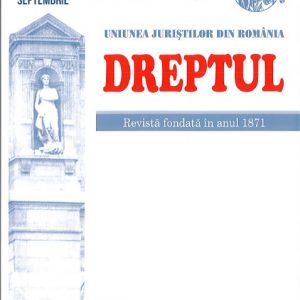 This article tries to bring into discussion the topic of naval laws throughout the last decades and, especially, the issue of safety on ship. Naval ship safety assurance is the process that provides confidence and it refers to the well-functioning of the ship, personnel, third parties and property. The most important aspect of this topic includes the Law from February 1907, followed by the Decrees No 40/1950 and No 443/1972 and the Law No 191/2003. In this article, the author has chosen to give a brief description of the naval legislation that is respected in our country and to analyze the differences between it and the international norms regarding the same aspect.
This article tries to bring into discussion the topic of naval laws throughout the last decades and, especially, the issue of safety on ship. Naval ship safety assurance is the process that provides confidence and it refers to the well-functioning of the ship, personnel, third parties and property. The most important aspect of this topic includes the Law from February 1907, followed by the Decrees No 40/1950 and No 443/1972 and the Law No 191/2003. In this article, the author has chosen to give a brief description of the naval legislation that is respected in our country and to analyze the differences between it and the international norms regarding the same aspect. -
 The labour law – a branch and science of the Romanian law system – has come a long way to the present days, when it fully manifests its specificity and autonomy that characterizes it. The doctrine evokes a „labour contract” concluded according to rules of the Roman law. In the Middle Ages, the Romanian principalities did not know regulations regarding legal labour relations. It was only in the Civil Code of 1864 that there were established specific regulations of some civil contracts which included some elements of some labour relations. The appearance and development of the industry determined, at the end of the 19th century and the beginning of the 20th century, the adoption of some legal norms aimed at the protection of workers. The labour legislation was invigorated due to the rules of the International Labour Organization, established in 1919. Our country, as a founding member, has ratified the essential conventions of this organization in the interwar period, but also later, to the present days. About a labour law, distinct, autonomous in Romania, one can speak only after the entry into force of the Labour Code of 1950. The development of the Romanian society, its economic and social level have also determined the evolution of the labour legislation and of the labour law, as it will be shown in the elaborated study.
The labour law – a branch and science of the Romanian law system – has come a long way to the present days, when it fully manifests its specificity and autonomy that characterizes it. The doctrine evokes a „labour contract” concluded according to rules of the Roman law. In the Middle Ages, the Romanian principalities did not know regulations regarding legal labour relations. It was only in the Civil Code of 1864 that there were established specific regulations of some civil contracts which included some elements of some labour relations. The appearance and development of the industry determined, at the end of the 19th century and the beginning of the 20th century, the adoption of some legal norms aimed at the protection of workers. The labour legislation was invigorated due to the rules of the International Labour Organization, established in 1919. Our country, as a founding member, has ratified the essential conventions of this organization in the interwar period, but also later, to the present days. About a labour law, distinct, autonomous in Romania, one can speak only after the entry into force of the Labour Code of 1950. The development of the Romanian society, its economic and social level have also determined the evolution of the labour legislation and of the labour law, as it will be shown in the elaborated study. -
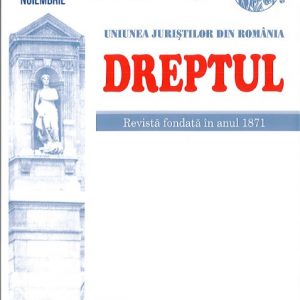 In this study the author presents the focus points regarding the evolution of maritime laws and the most important aspects in respect of free shipping and trading between states. Therefore, there are examined legal aspects concerning the status of all the motorways of the sea, the natural straits, the ship registration and the ownership of the vessel. The Geneva Convention on the High Seas of 1958, the United Nation Convention on the Law of the Sea of 1982 and the United Nations Conference on Trade and Development are essential and represent the basis for today’s maritime laws and regulations.
In this study the author presents the focus points regarding the evolution of maritime laws and the most important aspects in respect of free shipping and trading between states. Therefore, there are examined legal aspects concerning the status of all the motorways of the sea, the natural straits, the ship registration and the ownership of the vessel. The Geneva Convention on the High Seas of 1958, the United Nation Convention on the Law of the Sea of 1982 and the United Nations Conference on Trade and Development are essential and represent the basis for today’s maritime laws and regulations. -
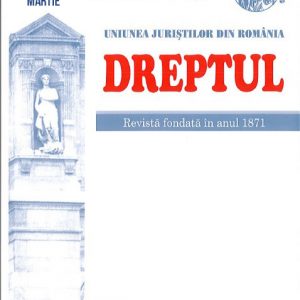 Ideea de reparație este, cum scria un autor, „una din cele mai vechi idei morale ale omenirei” (G. Ripert, La règle morale dans les oblig. civiles nr. 121, p. 223). În decursul timpurilor ea a suferit o serie de transformări, a parcurs mai multe etape, rezumate în cele 4 subtitluri ale studiului de față, care urmărește numai să schițeze în linii mari sensul acestei atât de interesante evoluții, care are semnificația drumului penibil al însăși ideei de Dreptate. Noțiunea de răspundere, în adevăr, se situiază în centrul tuturor instituțiunilor juridice care au de obiect reglementarea raporturilor între indivizi în societate, având un rol regulator și sancționator, întru cât tinde la păstrarea echilibrului rupt prin actele ilicite, fie că sunt violări de obligațiuni contractuale, fie că au caracterul și mai grav al călcării unor norme de conduită, pe pare societatea însăși le impune și îndeosebi acea normă negativă universală de neminem laedere, care constitue în esență principiul din care decurge însăși ideea de răspundere.
Ideea de reparație este, cum scria un autor, „una din cele mai vechi idei morale ale omenirei” (G. Ripert, La règle morale dans les oblig. civiles nr. 121, p. 223). În decursul timpurilor ea a suferit o serie de transformări, a parcurs mai multe etape, rezumate în cele 4 subtitluri ale studiului de față, care urmărește numai să schițeze în linii mari sensul acestei atât de interesante evoluții, care are semnificația drumului penibil al însăși ideei de Dreptate. Noțiunea de răspundere, în adevăr, se situiază în centrul tuturor instituțiunilor juridice care au de obiect reglementarea raporturilor între indivizi în societate, având un rol regulator și sancționator, întru cât tinde la păstrarea echilibrului rupt prin actele ilicite, fie că sunt violări de obligațiuni contractuale, fie că au caracterul și mai grav al călcării unor norme de conduită, pe pare societatea însăși le impune și îndeosebi acea normă negativă universală de neminem laedere, care constitue în esență principiul din care decurge însăși ideea de răspundere. -
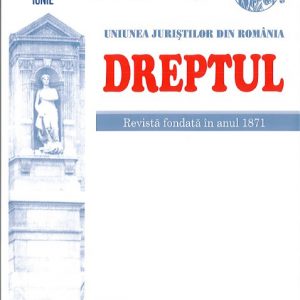 This scientific approach debates and proposes solutions for a problem of judicial practice also reflected in the doctrine of speciality, namely whether it subsists the offence of tax evasion provided in Article 9 (1) b) or c) of the Law No 241/2005, whose active subject is a legal person, in case of absence of the accounting records of the taxpayer. The author’s certain conclusion is based on arguments related to the legal text and which the practice has embraced as a corollary, and he proposes a solution in the sense that the judicial bodies may analyse that all the constituent elements of the reference offence are present even in the absence of the documents of accounting records. Likewise, the article also deals tangentially with a possible problem related to the constitutionality of a legal phrase that is part of the constituent elements of the offence of tax evasion and criticizes the redundant and incoherent phrasing of the legislator.
This scientific approach debates and proposes solutions for a problem of judicial practice also reflected in the doctrine of speciality, namely whether it subsists the offence of tax evasion provided in Article 9 (1) b) or c) of the Law No 241/2005, whose active subject is a legal person, in case of absence of the accounting records of the taxpayer. The author’s certain conclusion is based on arguments related to the legal text and which the practice has embraced as a corollary, and he proposes a solution in the sense that the judicial bodies may analyse that all the constituent elements of the reference offence are present even in the absence of the documents of accounting records. Likewise, the article also deals tangentially with a possible problem related to the constitutionality of a legal phrase that is part of the constituent elements of the offence of tax evasion and criticizes the redundant and incoherent phrasing of the legislator. -
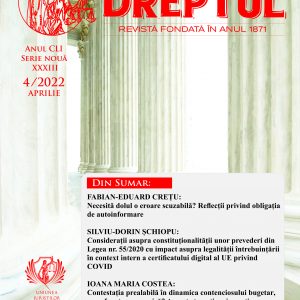
-
 The European arrest warrant is an extremely relevant subject these days, being one of the concerns of the European lawmaker, the EU Member States and the national authorities (Ministry of Justice, courts of law, prosecutor’s offices, police structures) involved in this field. In this article, the author presents the main particularities of the European arrest warrant enforcement in the EU Member States, emphasizing both its positive aspects and the difficulties met by the Member States in transposing the provisions of the Framework Decision no.2002/584/JHA of 13 June 2002 on the European arrest warrant and the surrender procedures between Member States.
The European arrest warrant is an extremely relevant subject these days, being one of the concerns of the European lawmaker, the EU Member States and the national authorities (Ministry of Justice, courts of law, prosecutor’s offices, police structures) involved in this field. In this article, the author presents the main particularities of the European arrest warrant enforcement in the EU Member States, emphasizing both its positive aspects and the difficulties met by the Member States in transposing the provisions of the Framework Decision no.2002/584/JHA of 13 June 2002 on the European arrest warrant and the surrender procedures between Member States.
